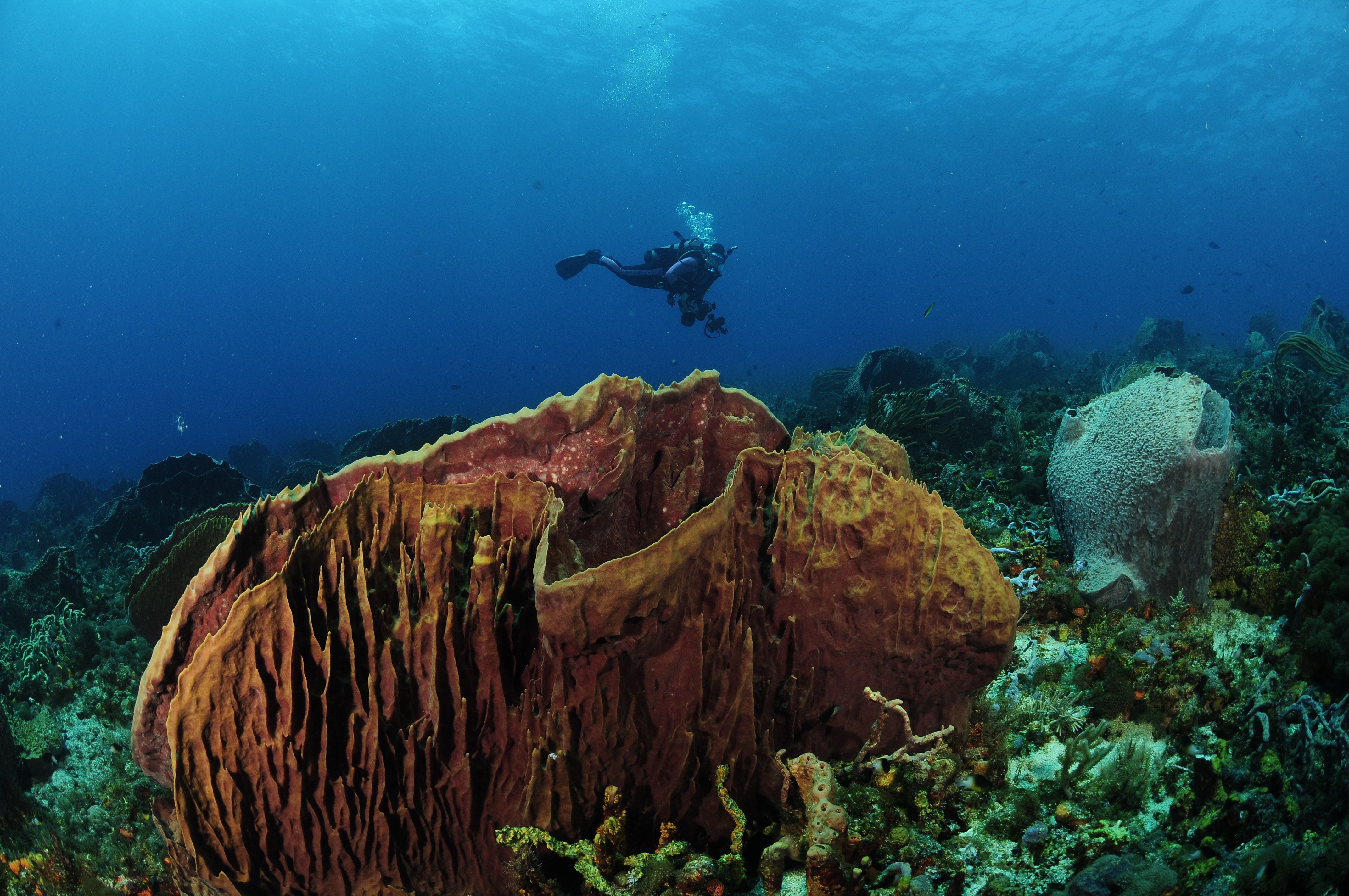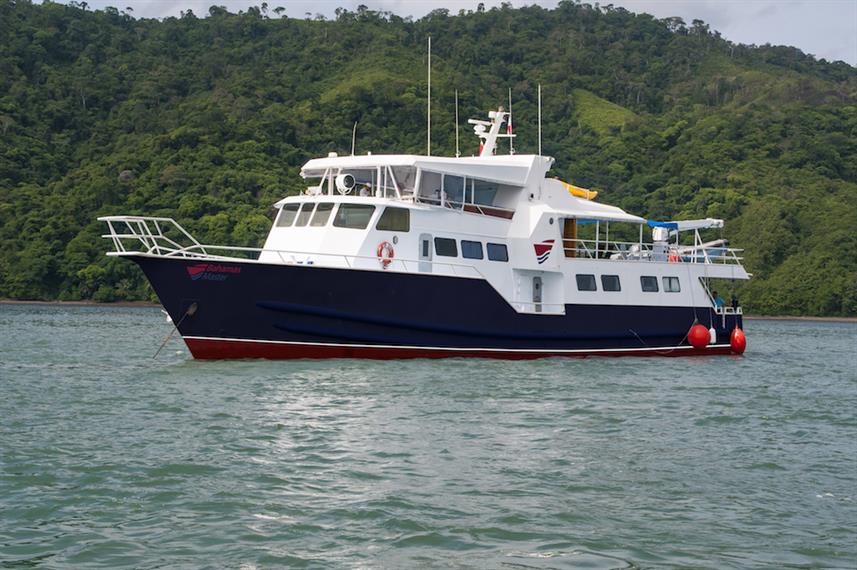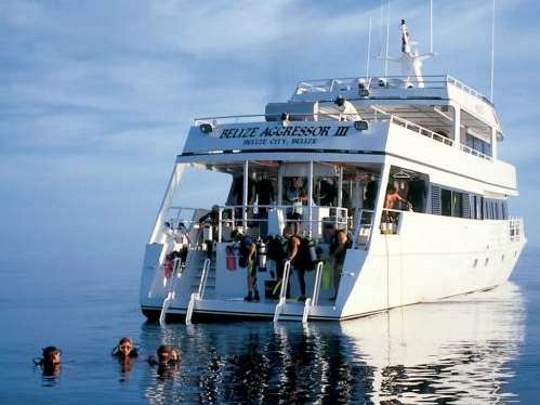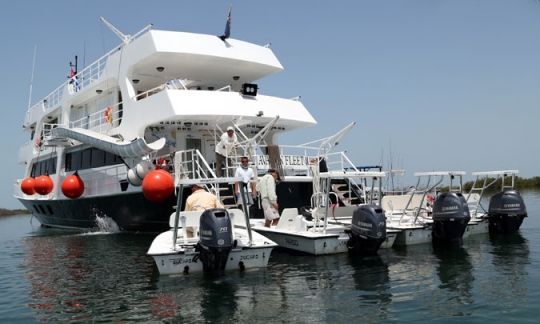
Updated April 3, 2022
This is the thirty-seventh in a series of reviews of the best scuba diving destinations around the world. In this post, the focus is on Trinidad and Tobago scuba diving.
In addition to this series on dive resort locations, the best worldwide liveaboard dive locations and services are reviewed in their own series. To check them out, or others in this series, click on Liveaboards / Resorts on the menu at the top and choose a title from the list.
Have you ever been diving in Trinidad and Tobago? If so, I’d love to know about your experience. What dive shop or liveaboard did you use? Which dive spots are the best and what are the conditions there regarding the visibility, current, water temperature, sealife attractions, etc.? Please post your response in the comments section at the bottom and we’ll all learn something we can use.
Trinidad and Tobago Scuba Diving
Background
Situated 130 kilometers (81 miles) south of Grenada and only 11 kilometers (6.8 miles) to the northeast of Venezuela is Trinidad and Tobago, the southernmost country in the West Indies. With the two larger and many very small islands, it has an area of 5,128 square kilometers (1,980 square miles) and a population of around 1.5 million with 50,000 living on Tobago.
In a comparison of per capita GDP in the Americas, it is behind only the U.S. and Canada and has a diverse economy with emphasis on petroleum, natural gas, petrochemicals, tourism, manufacturing, financial services, steel, fishing, citrus, and cocoa.
This constitutional republic has a rich multicultural population derived from African slaves and Indian indentured laborers with a variety of other ethnicities also represented. The national language is English with most speaking the local Creole variation. Culturally very rich, Trinidad is where calypso, limbo, steelpan, and several other musical styles developed and a world-renowned Carnival is celebrated annually. Two Nobel Prize-winning authors called Trinidad and Tobago home at one point or another, V.S. Naipaul and Derek Wolcott.

Undersea World
The Orinoco River drains out of the continent just to the south and the Guyana current brings the plankton-rich water to Trinidad decreasing the visibility significantly while providing the nutrients to attract creatures like manta rays and whale sharks which are not as often seen in other Caribbean waters. Several varieties of turtle are there in numbers and the West Indian Manatee is sometimes sighted.
By the time the current makes its way up to Tobago decreased visibility is no longer a problem. Tobago has shallow rich reefs with 300 species of coral including elkhorn, staghorn, and fire coral, huge barrel and tube sponges, and a large variety of gorgonians, sea fans, plumes, and whips. The north end is known for strong currents and its hard and soft corals, black coral, and sponges. Highlight areas are Speyside, Little Tobago, and Goat Island. The south end has less current and there are many mini-walls and sharks and dolphins. It is known for clear water at Nylon Pool and Buccoo Reef National Park.
Featured sea life includes this list: crabs, nudibranchs, garden eels, squid, lobster, seahorses, octopus, moray eels, frogfish, scorpionfish, dwarf, Queen and French angelfish, blue chromis, bicolor damselfish, jacks, rainbow runners, black groupers, porkfish, big eye, glass eye and cubera snappers, blue wrasses, African pompano, barracuda, tarpon, manatees, dolphins, Bermuda chub, manta rays, blacktip reef sharks, scalloped hammerhead sharks, nurse sharks, whale sharks, Atlantic guitarfish, southern stingrays, torpedo rays, and hawksbill, green and leatherback turtles.
Seasons and Conditions
It is consistently warm year-round in Trinidad and Tobago.
- Daily temperatures range from 24-29°C (75-85°F).
- There is a rainy season from June to December when typically it is sunny in the morning and rains a bit in the afternoon. The islands are south of the hurricane belt and are not usually hit with big storms.
- Water temperatures average 25°C (77°F) in the winter months and 28°C/82.4°F in summer. At the coolest, divers will want to consider a 3 mm full or shorty wetsuit.
- Visibility runs from 15-30 meters (50-100 feet) around Tobago and around 10-20 meters (35-68 feet) near Trinidad.
- As indicated above, a strong current does occur at the north end of Tobago.
- Some sites can be accessed from shore, but many will require a boat.
- Divers of all levels will find suitable diving in Trinidad and Tobago.
Liveaboard Diving
Trinidad and Tobago is not an area renowned for liveaboard diving, but there are many cruises in other areas around the Caribbean. Below are several great yachts to check out:
Avalon II, Jardines de la Reina Cuba Liveaboard Diving – Check the Price & Details
 Turks & Caicos Explorer II, Turks & Caicos Liveaboard Diving – Check the Price & Details
Turks & Caicos Explorer II, Turks & Caicos Liveaboard Diving – Check the Price & Details
 Bahamas Master, Bahamas Liveaboard Diving – Check the Price & Details
Bahamas Master, Bahamas Liveaboard Diving – Check the Price & Details
 Belize Aggressor III, Belize Liveaboard Diving – Check the Price & Details
Belize Aggressor III, Belize Liveaboard Diving – Check the Price & Details
For reviews of diving in other Caribbean locations, please click on these posts:
- Scuba Diving in Islamorada Florida
- Scuba Diving on Key West Florida
- Best Scuba Diving Key Largo Florida
- Scuba Diving West Palm Beach Florida
- Ft. Lauderdale Scuba Diving
- Scuba Diving St. Barts
- Scuba Diving St. Eustatius
- Scuba Diving in Saba
- Scuba Diving St Kitts and Nevis
- Best Scuba Diving St. Martin
- Scuba Diving Ambergris Caye Belize
- Best Guadeloupe Scuba Diving
- Anguilla Scuba Diving
- Scuba Diving in Antigua and Barbuda
- Best Scuba Diving Jamaica
- Scuba Diving Cuba Best Dive Sites Cuba
- Best Cuba Scuba Diving Liveaboard Jardines de la Reina
- Scuba Diving the Dominican Republic
- Best Scuba Diving Panama
- Banco Chinchorro Diving Mexico
- Scuba Diving Playa Del Carmen
- Scuba Diving Tulum Mexico
- Cozumel Scuba Diving Review
- Scuba Diving Cancun Mexico
- Best Scuba Diving Puerto Rico
- Scuba Diving St Vincent and the Grenadines Review
- St. Lucia Scuba Diving Review
- Turks and Caicos Scuba Diving Review
- Best US Virgin Islands Vacations Scuba Diving
- Best Caribbean Beach Vacations Curacao Scuba Diving
- Best Caribbean Diving Destinations Aruba
- Best Caribbean Dive Vacations Bonaire
- Best Tropical Island Vacations Dominica Scuba Diving
- Best Caribbean Scuba Diving Los Roques Venezuela
- Barbados Scuba Dive Vacations
- Grenada Scuba Diving Review
- Best Scuba Diving Caribbean – Martinique
- Best British Virgin Island Diving Liveaboard
- Best Bahamas Liveaboard Scuba Vacations
- Best Belize Dive Trips & Cocos Island Diving


A Selection of the Best Tobago Dive Sites
The Sisters – to 40 meters (130 feet), 5 pinnacles which rise 30 meters (100 feet) out of the water, rocks, ledges and caverns, soft coral, lobster, moray eels, turtles, large pelagics, nurse sharks, hammerhead sharks, stingrays, turtles, 2.4 kilometers (1.5 miles) west of Tobago Island, experienced level
Kedleston Drain aka Keleston Deep or Little Tobago – to 18 meters + (60 feet), drift dive across a plain of rich coral that descends from 9-18 meters (30-60 feet), a giant 3×5 meter (10×15 foot) brain coral, sponges, gorgonians, sea whips, other hard corals, large barracuda, green morays, Creole wrasse, jacks, reef sharks and manta rays in season (March to July more likely), experienced level
MV Maverick – 30 meters (100 feet) maximum depth, 107-meter (350 foot) car ferry scuttled to become a reef in 1997, deck at 15 meters (50 feet), rich corals, barracuda, turtles, eagle rays, cobia, variety of schooling fish, easy penetration possibilities, experienced level (see video below)
Flying Reef – 15 meters (50 feet), fast current possible, soft corals, huge sponges, plate corals, a rich variety of colorful reef fish, stingrays, turtles, schools of big-eye and glass eye snappers and Bermuda chub, French angelfish, porkfish, porcupine puffers, beginner to experienced level
Japanese Garden – 22 meters (73 feet) average depth, vase and tube sponges, sea whips, mild to strong currents sweep along a gentle slope to a crevice known as Kamikaze Cut, then a sheltered area out of the current, Creole wrasse, barracuda, reef sharks, jacks, a chance of manta rays, experienced level
London Bridge – 8 meters (25 feet) deep, 4-meter (13 foot) wide eroded arch passageway in the surf zone, rich reef surroundings with brain corals and sponges, lobsters, moray eels, schooling jacks and tuna, green morays, turtles, parrotfish, experienced level
Landslide – shallow sheltered site in Man o’ War Bay, soft and hard corals, rich macro life, frogfish, shrimp, seahorses, guitarfish, stingrays, turtles, all levels
Gardener Rock – 33 meters (110 feet), the rock rises from the bottom and breaks the surface, soft corals and sponges, rich macro life, barracuda, turtles, experienced level
King’s Bay – variable depth profiles, the current is based on tidal conditions, garden eels, moray eels, eagle rays, shoaling reef fish, all levels
Diver’s Thirst – 25 meters (83 feet), south side site, rich encrusting corals, dense fish schools, strong current possible, nurse sharks, blacktip reef sharks, eagle and manta rays, stingrays, turtles, possible bull and tiger sharks, experienced level
Mt. Irvin Wall and Extension – shallow wall close to shore extending deeper along the rocks of Mt. Irvin Bay, canyons, ledges, crevices with seahorses and macro life, large schools of fish, tarpon, cobia, eagle rays, all levels
Trinidad and Tobago Photos
With macro life, sharks, rays, pelagics, dolphins, wrecks, clear water, a beautiful, diverse coral reef, lots of fish, and historic and colorful onshore targets, there are many excellent photo opportunities. For information and reviews of dive cameras, click here:
Trinidad and Tobago Transportation, Lodging, and Diving Services
Transportation
Piarco International Airport in Trinidad is the country’s major airport with regular daily flights from America, Europe, and other Caribbean countries. Tobago also has an international airport, A.N.R. Robinson International Airport with less frequent service. The islands have a good highway system and a wide range of buses, taxis, shuttle services, and car rentals. Ferries run between Port of Spain (Trinidad) and Scarborough (Tobago) and there is a water taxi service between Port of Spain and San Fernando to the south on Trinidad.
Lodging and Dive Shops
There are many dozens of hotels and accommodations of every grade from $35 to over $660 per night. For scuba diving, I recommend staying in Tobago where there is a greater concentration of good dive sites and more of a holiday resort atmosphere. Several hotels there have in house dive shops. Otherwise, there are a dozen or more separate dive operations.
This website is a good source for the available options and can arrange a booking:
Trinidad and Tobago Tourist Attractions (aside from scuba diving)
Aside from seaside activities and beaches, Trinidad and Tobago have a very rich and diverse culture to enjoy. There are many historic buildings and sites, museums, galleries, gardens, shopping, food, restaurants, nightlife and natural sites including Fort James and Fort King George, Main Ridge Forest Reserve, Nanan’s Caroni Bird Sanctuary, the National Museum and Art Gallery, Piparo Mud Volcano, Pigeon Point, the Royal Botanic Gardens, Stillmeyer’s Castle, Temple in the Sea, the Nylon Pool, Adventure Farm and Nature Reserve, Argyle Falls, Asa Wright Nature Center, Hindu festivals, Carnival, leatherback turtle nesting, mountain biking, traditional and underground music, Crusoe’s Cave, horseback riding, goat racing, and many others. The video below provides a little context.
Scuba Diving Trip Insurance
A cushion for emergencies provides peace of mind when on vacation. I recommend this diving insurance as they have worldwide coverage and provide scuba divers quality insurance and medical assistance service.
Feedback and Comments
I hope you found this post on scuba diving Trinidad and Tobago interesting and useful. If you have any questions or ideas, please feel free to share them in the comments section. I’d love to know of any experience you have diving there. If there is no comments section directly below, click here: >>comments<<

I’m a big fan of scuba diving. I haven’t personally gone or done scuba diving myself, but I have always wanted to try it out. This article has all the information I would need about doing it in Trinidad. I’m not sure if I’m ever going there, but if I do this article is an essential one. Thank you so much for sharing this article.
It is going to be a useful one for everyone who is traveling to Trinidad.
Hi Sujandar,
You are back again. Thanks for your interest.
You haven’t gone diving yet, but I see you do have the interest to check out my site. I explained to you earlier what it takes to complete a beginning open water diver course. I hope you decide to give it a try someday. If you have any questions, please get in touch.
Best regards,
Joe
Thank you Joe for sharing ¨Best Trinidad and Tobago Vacations Scuba Diving¨ I quite agree that Trinidad and Tobago may be one of the best dive resorts location around the world, but I feel apprehensive visiting due to safety concerns. I understand that criminal activity is on the rise and tourists are sometimes targeted. Travellers have reported pickpocketing and armed assaults in certain parts of Port Spain. I’ve been told to be cautious after dark when leaving the nation´s main airport outside of Port of Spain, as incidents of armed robbers and accosting vehicles have been reported. On both islands, the US Embassy advises tourists to choose accommodation with adequate 24-hour security. You are also advised to always lock your car doors and stay on alert when visiting isolated beaches. Do you think these claims are exaggerated?
Hi Enrique,
Thanks a lot for your kind comments and concern for safety.
Caution is well advised. I suggest anyone going to Trinidad and Tobago read this travel advisory from the US government – https://travel.state.gov/conte…, and this one from the UK – https://www.gov.uk/foreign-tra…. On a bit of a positive note, violence is considered rare.
Where I recommended in my post to go diving is Tobago, where conditions are considered safer. I hope things will improve enough for these government agencies to provide more positive information soon.
Best regards,
Joe